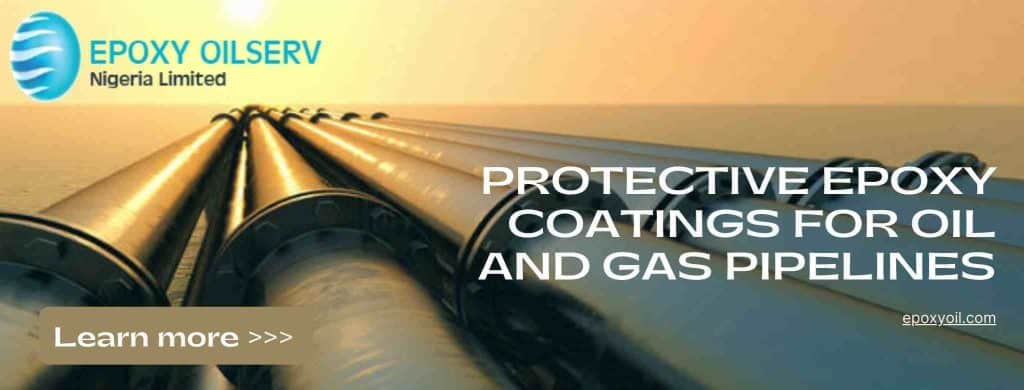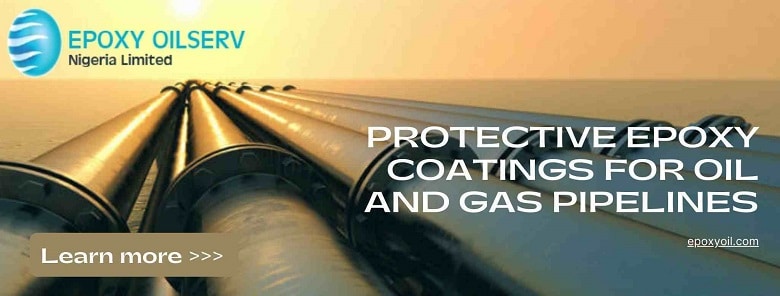PROTECTIVE EPOXY COATINGS FOR OIL AND GAS PIPELINES
Table of contents
Introduction
What is epoxy coating?
Types of pipeline location
Introduction
Pipelines are a safe and efficient means of high volume transportation of oil and gas. They are expected to resist the damaging effects of the surrounding environment and the potential damage from the material that is being conveyed might cause.
Corrosion is an important form of pipeline deterioration due to aggressive environments. Buried pipes are located with continuously changing environmental conditions which may lead to corrosive environment. Various coatings, paints or cathodic protections are usually used to protect pipes against the effect of external corrosion. Corrosion may become a serious problem as the pipeline ages.
Oil and gas pipelines are an essential part of the energy infrastructure and their coatings must meet a multitude of standards which includes;
- It preserves the equipment
- It protects from corrosion,
- It follows federal regulations
- Quick to apply for fast-moving pipeline owners
Coatings provide an effective method used for the protection of pipelines against corrosion. They provide a physical corrosion barrier between the steel structure and the surrounding environment. They are the first external corrosion protection method for pipelines. As such, the selection and continued integrity of pipeline coating is of paramount importance.
The pipeline coating plays an important role in the corrosion protection system.Its effectiveness is essential for the piping system durability and due to the difficulty of their inspection, mainly for buried or immersed pipelines in deep waters, it is essential that the use of coatings should provide the same properties as the one expected for the piping system.
Pipeline corrosion is most prevalent when the breakdown of coatings inhibitors or cathodic protection takes place in a corrosive environment, where coating defects such as holidays and disbondments allow for reasonable contact between the steel with the wet soil or petroleum product, in the case of internal corrosion . How severe the corrosion is and how quickly the integrity of the pipeline is compromised is still an outstanding issue that requires critical analysis. The durability of a pipeline depends on the selection of the coating.
What is epoxy coating
Epoxy coating is made up of epoxy resin (epichlorohydrine+Bisphenol) and hardener (an amide). It acts as a waterproof material, highly resistant to heat up to 1500C, rust and acid which makes it the best for pipeline coating.

Pipeline coatings should be inspected both visually and by a holiday detector set at the proper voltage before the pipe is lowered into the water. Periodic inspection of the pipeline cathodic protection potential is used to identify the coating breakdown areas.
Coatings are selected based on the design temperature and cost. The principal coatings in rough order of cost are:
•Tape wrap
•Asphalt
•Coal tar enamel
•Fusion-bonded epoxy (FBE)
•Cigarette wraps polyethylene (PE)
•The extruded thermoplastic PE and polypropylene (PP)
The most commonly used external coating for a subsea pipeline is fusion-bonded epoxy. These are thin-film coatings, 0.5–0.6 mm thick. They consist of thermosetting powders applied to a white metal blast-cleaned surface by electrostatic spray. The powder melts on the preheated pipe (around 230°C), flows and subsequently cures to form thicknesses of between 250 and 650 microns. Epoxy coatings for oil and gas applications offer excellent resistance to high temperatures, chemicals, and corrosion. The Standard of Epoxy coating for oil and gas pipeline depends on the location of the pipeline.
Types of pipeline Location
There are three major types of pipeline location:
- Above-ground pump stations
- Below-ground buried systems
- Underwater pipelines
ABOVE GROUND PUMP STATIONS
For the above-ground pump stations and compressor stations where pressure is reintroduced into the pipeline to maintain flow, pipeline coatings that protect against atmospheric conditions (wind, rain, UV, infrared) are the standard. This is typically an inorganic zinc primer, an intermediate coat of epoxy, then a top coat of polyurethane for color and gloss retention. Joint coatings are field-applied with the same coating system as the body of the pipeline. Cathodic protection isn’t used on the above-ground sections of the pipeline.
BELOW-GROUND BURIED SYSTEM
For buried systems, almost-universal standard pipeline coating is fusion bond epoxy (FBE) powder systems. FBE has become the standard because it is easy to apply, affordable, works well with cathodic protection and is tough enough to withstand transportation from the shop, to the truck and field. A section at each end of the pipe is left for the field-applied joint coatings; either a three-layer shrink wrap, or a high-performance 100 percent solid liquid-applied epoxy. The drawback of the epoxy is the cure time, which is not ideal for fast-moving pipeline projects.
As buried systems are in an immersive environment (i.e. surrounded by water), cathodic protection is a must, and is always used in conjunction with the FBE (Fusion Bond Epoxy) system. The coating system and the cathodic protection have a synergistic relationship, as the coating deteriorates with age and develops holidays, the cathodic protection takes over and ensures continued corrosion protection for the pipeline.
Cathodically protected pipelines are equipped with permanent test stations, where electronic leads are attached to the pipeline to measure the pipe-to-soil potential. This potential should be sufficiently cathodic to ensure adequate corrosion protection, but not so cathodic as to produce coating damage and or hydrogen embrittlement.
UNDERWATER PIPELINES
Though seemingly different from buried pipeline systems, underwater pipelines are actually in quite a similar environment, as they are both immersive. These pipelines are either pre-coated with three layers of FBE, or applied with coal tar urethane on site. The choice between these two is based on the personal preference of the pipeline owner, though coal tar urethane’s health and safety concerns have seen it fall out of favor in recent years.
As with buried pipelines, underwater pipeline coatings are used in conjunction with sacrificial cathodic protection. One additional element that’s added to underwater pipelines is concrete weight coatings; some poured and laid on-site, some pre-cast to ensure the pipeline stays at the desired depth and does not float out of the water.
Contact us for the availability of Epoxy coating for pipelines.

